TINY+
We define here a programming language called TINY+, which is a
superset of TINY in that it includes declarations, if statement, do-while
statement, string type and so on.
The following consists of:
1 Lexical conventions of the language, including a description of the
tokens of the language
2 EBNF description of each language construct
3 An description of the main semantics
4 Sample programs in TINY+
�
Part 1 Lexical Conventions of TINY+
1. The keywords of the language are the following:
true
false
or
if
then
else
and
end
not
int
bool
string while do
repeat until
read write
All keywords are reserved and must be written in lowcase
2. Special symbols are the following:
>
{
<=
>=
,
'
}
;
:= + -
* /
(
)
< =
3. Other tokens are ID, NUM and STRING which are defined by the
following regular expressions:
ID=letter (letter | digit)*
Identifier is letter followed by letters and digits
NUM=digit digit*
STRING=' any character except ' '
A STRING is enclosed in brackets '…', any character except ' can
appear in a STRING. A STRING can’t be defined more than a line
letter=a|…|z|A|…|Z
digit=0|…|9
Lower and uppercase letters are distinct
4. White space consists of blanks, newlines and tabs. White space is
ignored except that it must separate IDs, NUMs, and keywords
5. Comments are enclosed in curly brackets {…} and cannot be nested.
�
Comments can include more than one line.
�
Part 2 Syntax of TINY+
An EBNF grammar for TINY+ is as follows:
1 program
-> declarations stmt-sequence
2 declarations
-> decl ; declarations |ε
3 decl
-> type-specifier varlist
4 type-specifier -> int | bool | string
5 varlist -> identifier { , identifier }
6 stmt-sequence -> statement { ; statement }
7 statement ->
if-stmt
|
repeat-stmt
| assign-stmt
|
read-stmt
|
write-stmt | while-stmt
8 while-stmt -> while bool-exp do stmt-sequence end
9 if-stmt -> if bool-exp then stmt-sequence [else stmt-sequence] end
10 repeat-stmt -> repeat stmt-sequence until bool-exp
11 assign-stmt -> identifier:=exp
12 read-stmt -> read identifier
13 write-stmt -> write exp
14 exp -> arithmetic-exp | bool-exp | string-exp| comparison-exp
15 comparison-exp -> arithmetic-exp comparison-op arithmetic-exp
16 comparison-op -> < | = | > | >= | <=
17 arithmetic-exp -> term { addop term }
18 addop -> + | -
19 term -> factor { mulop factor }
�
20 mulop -> * | /
21 factor -> (arithmetic-exp) | number | identifier
22 bool-exp
-> bterm { or bterm }
23 bterm -> bfactor { and bfactor}
24 bfactor -> true |
false |
identifier | (bool-exp)
| not bfactor |
(comparison-exp)
25 string-exp
-> string | identifier
�
26 Part 3 Main semantics description of TINY+
A program consists of variable declarations and a sequence of
statements. Variable declarations may be empty but there must be
at least one statement.
All variables must be declared before they are used, and each
variable name can be declared only once
The type of variables and expressions may be int, bool or string,
type checking must be done on them
�
Part 4 Sample programs in TINY+
string str;
int x, fact;
str:= 'sample program in TINY+ language- computes factorial' ;
read x;
if x>0 and x<100 then {don’t compute if x<=0}
fact:=1;
while x>0 do
fact:=fact*x;
x:=x-1
end;
write fact
end
�
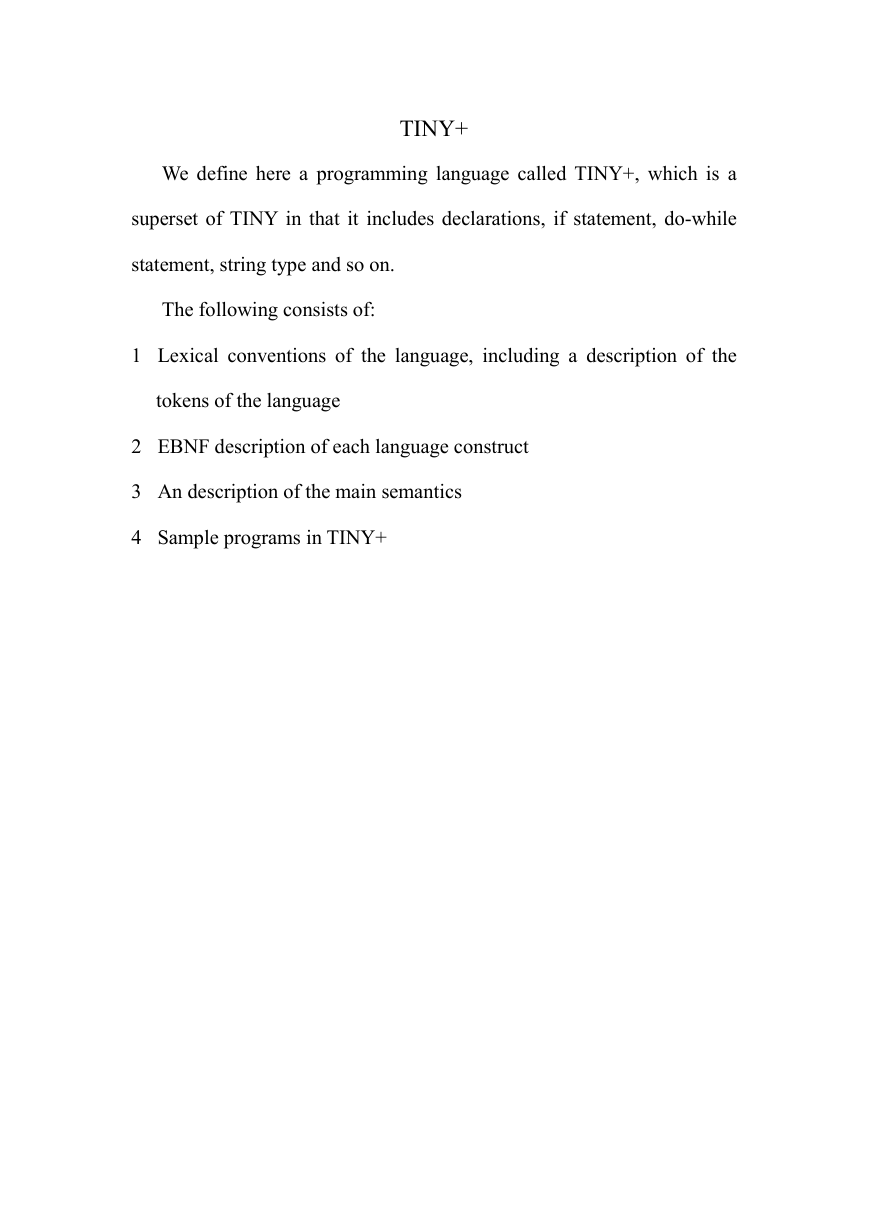
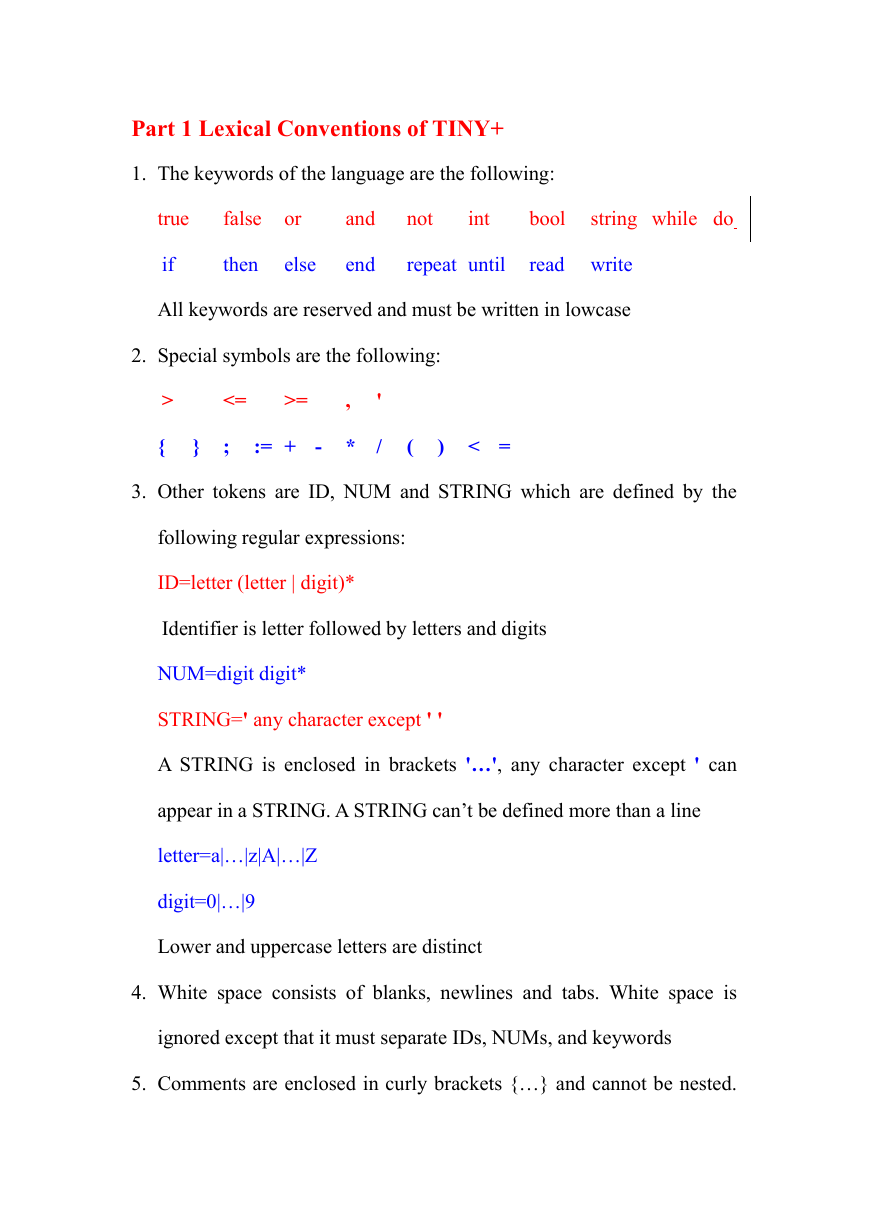

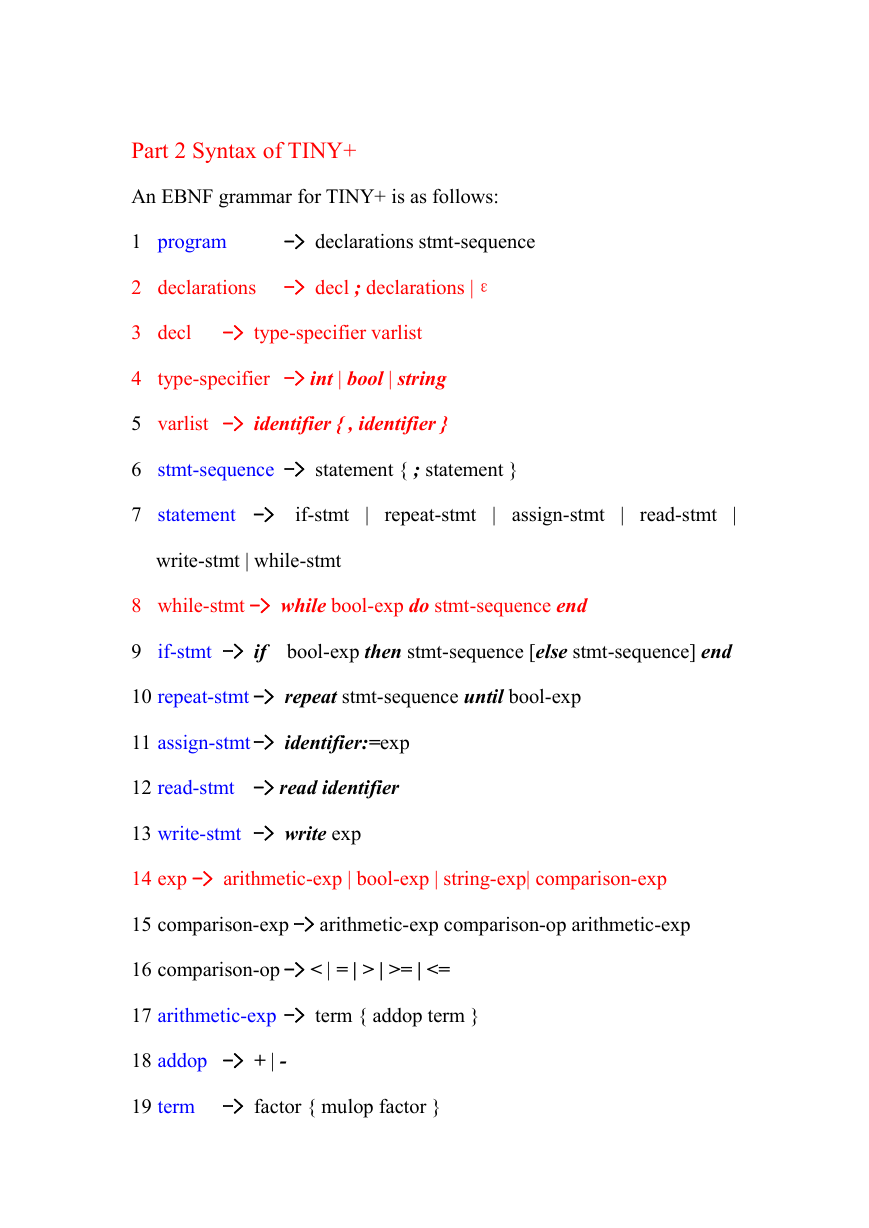
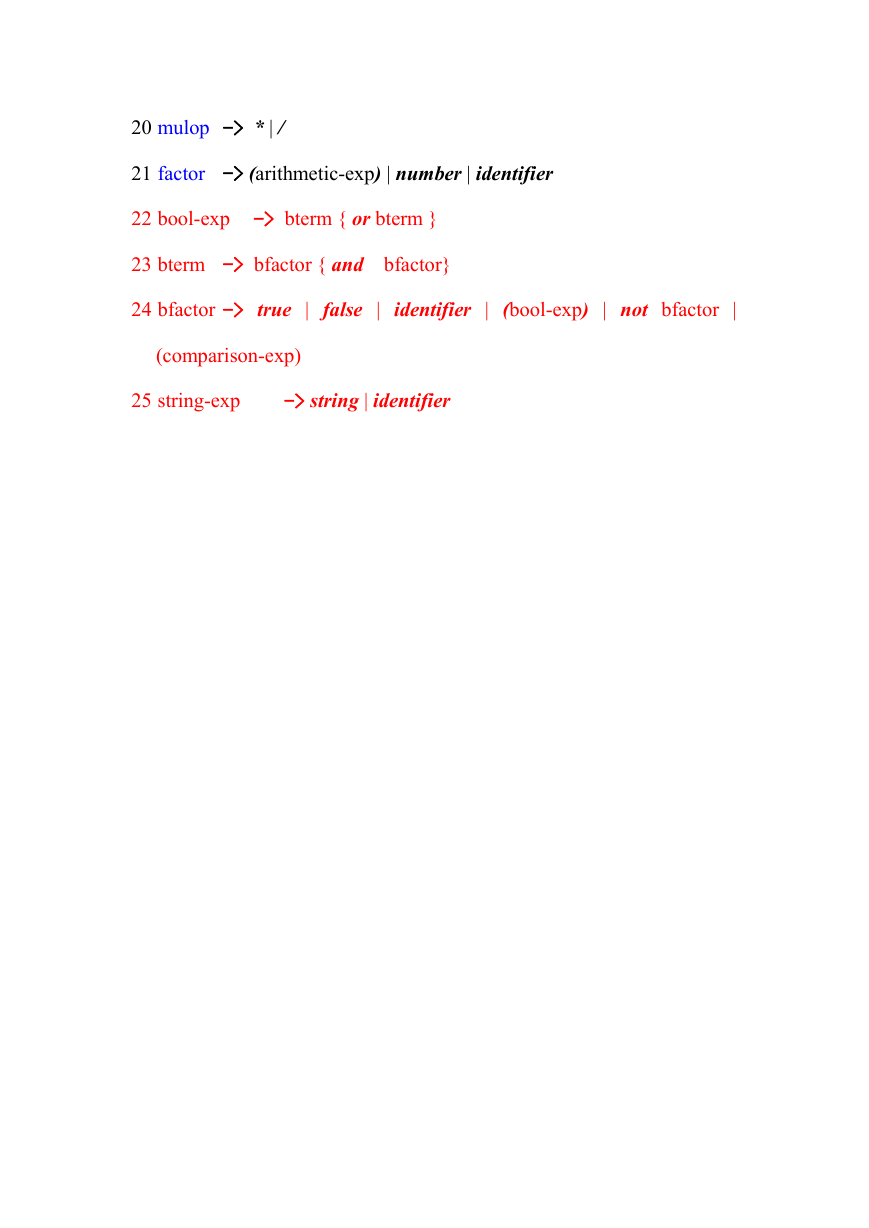
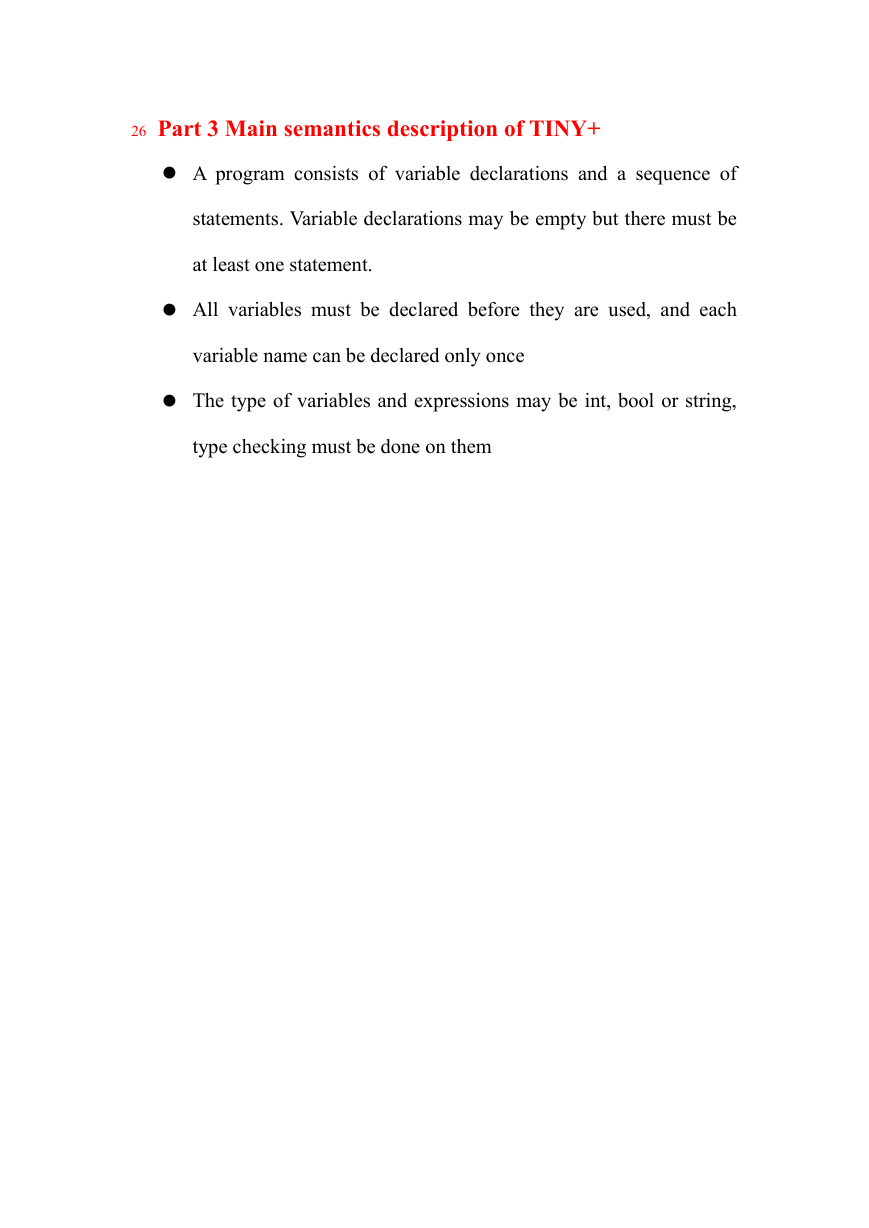








 2023年江西萍乡中考道德与法治真题及答案.doc
2023年江西萍乡中考道德与法治真题及答案.doc 2012年重庆南川中考生物真题及答案.doc
2012年重庆南川中考生物真题及答案.doc 2013年江西师范大学地理学综合及文艺理论基础考研真题.doc
2013年江西师范大学地理学综合及文艺理论基础考研真题.doc 2020年四川甘孜小升初语文真题及答案I卷.doc
2020年四川甘孜小升初语文真题及答案I卷.doc 2020年注册岩土工程师专业基础考试真题及答案.doc
2020年注册岩土工程师专业基础考试真题及答案.doc 2023-2024学年福建省厦门市九年级上学期数学月考试题及答案.doc
2023-2024学年福建省厦门市九年级上学期数学月考试题及答案.doc 2021-2022学年辽宁省沈阳市大东区九年级上学期语文期末试题及答案.doc
2021-2022学年辽宁省沈阳市大东区九年级上学期语文期末试题及答案.doc 2022-2023学年北京东城区初三第一学期物理期末试卷及答案.doc
2022-2023学年北京东城区初三第一学期物理期末试卷及答案.doc 2018上半年江西教师资格初中地理学科知识与教学能力真题及答案.doc
2018上半年江西教师资格初中地理学科知识与教学能力真题及答案.doc 2012年河北国家公务员申论考试真题及答案-省级.doc
2012年河北国家公务员申论考试真题及答案-省级.doc 2020-2021学年江苏省扬州市江都区邵樊片九年级上学期数学第一次质量检测试题及答案.doc
2020-2021学年江苏省扬州市江都区邵樊片九年级上学期数学第一次质量检测试题及答案.doc 2022下半年黑龙江教师资格证中学综合素质真题及答案.doc
2022下半年黑龙江教师资格证中学综合素质真题及答案.doc